TOYOTA AURIS HYBRID 2012 Owners Manual
Manufacturer: TOYOTA, Model Year: 2012, Model line: AURIS HYBRID, Model: TOYOTA AURIS HYBRID 2012Pages: 524, PDF Size: 26.34 MB
Page 141 of 524
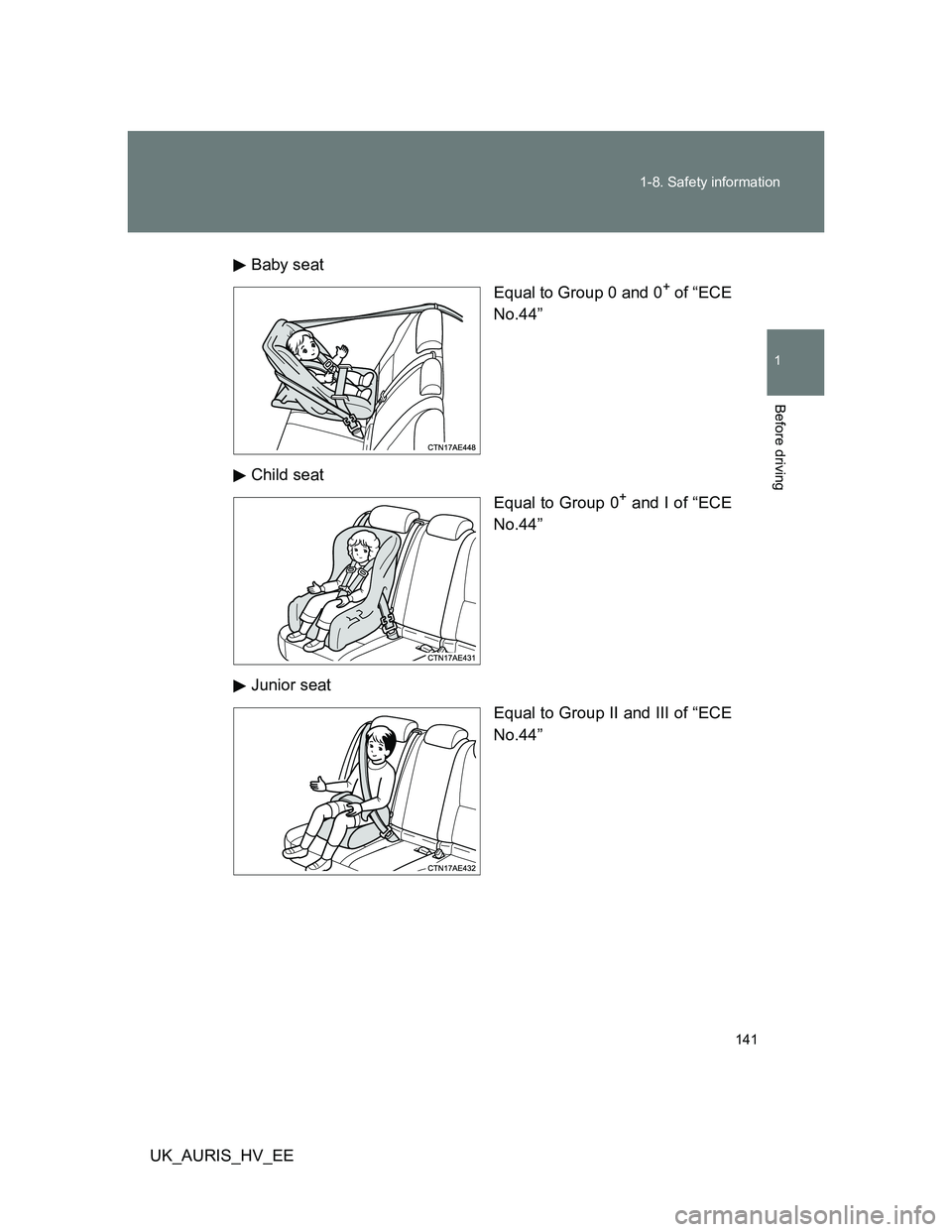
141 1-8. Safety information
1
Before driving
UK_AURIS_HV_EEBaby seat
Equal to Group 0 and 0
+ of “ECE
No.44”
Child seat
Equal to Group 0
+ and I of “ECE
No.44”
Junior seat
Equal to Group II and III of “ECE
No.44”
Page 142 of 524
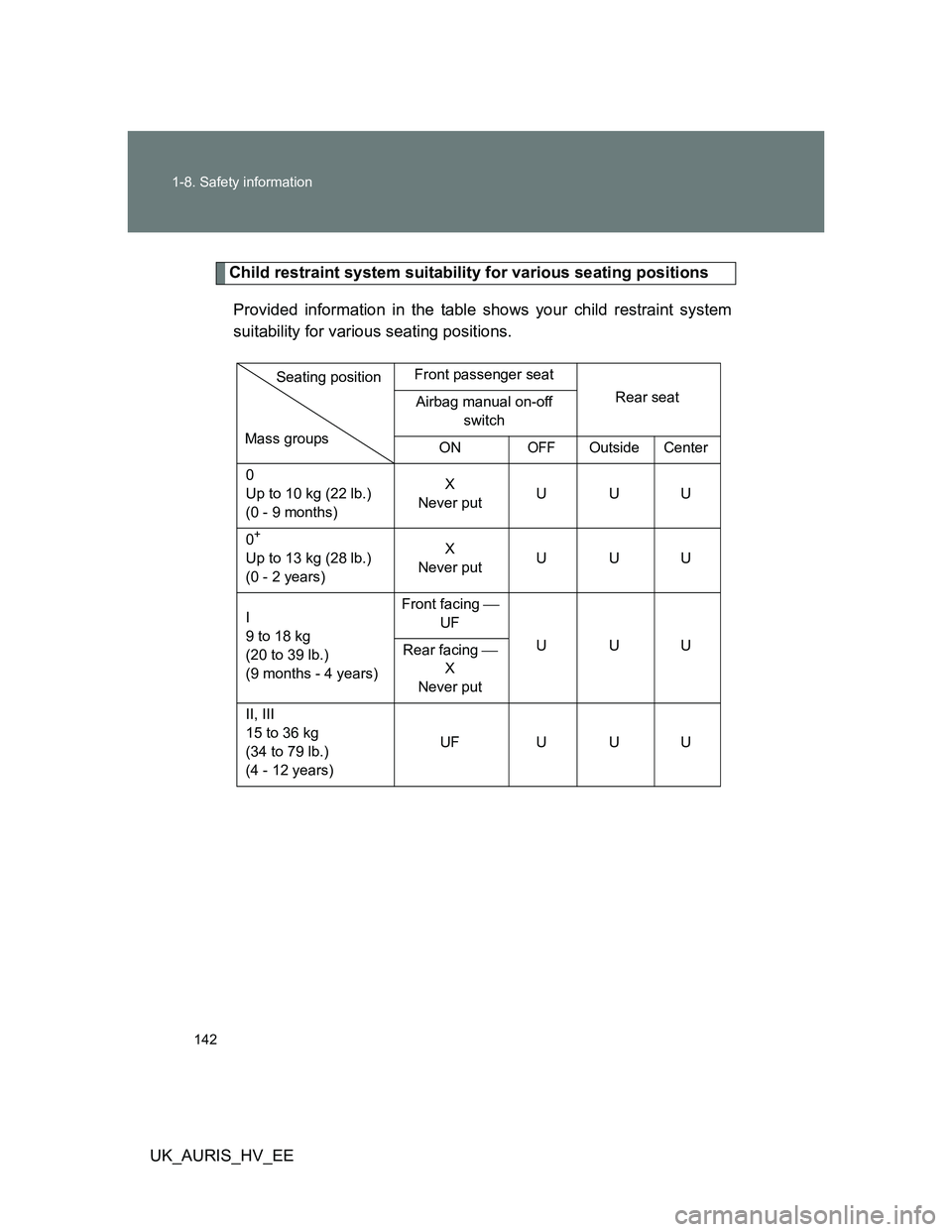
142 1-8. Safety information
UK_AURIS_HV_EE
Child restraint system suitability for various seating positions
Provided information in the table shows your child restraint system
suitability for various seating positions.
Front passenger seat
Rear seat
Airbag manual on-off
switch
ON
OFFOutside Center
0
Up to 10 kg (22 lb.)
(0 - 9 months)X
Never putUUU
0
+
Up to 13 kg (28 lb.)
(0 - 2 years)X
Never putUUU
I
9 to 18 kg
(20 to 39 lb.)
(9 months - 4 years)Front facing
UF
UUU
Rear facing
X
Never put
II, III
15 to 36 kg
(34 to 79 lb.)
(4 - 12 years)UF U U U
Mass groupsSeating position
Page 143 of 524
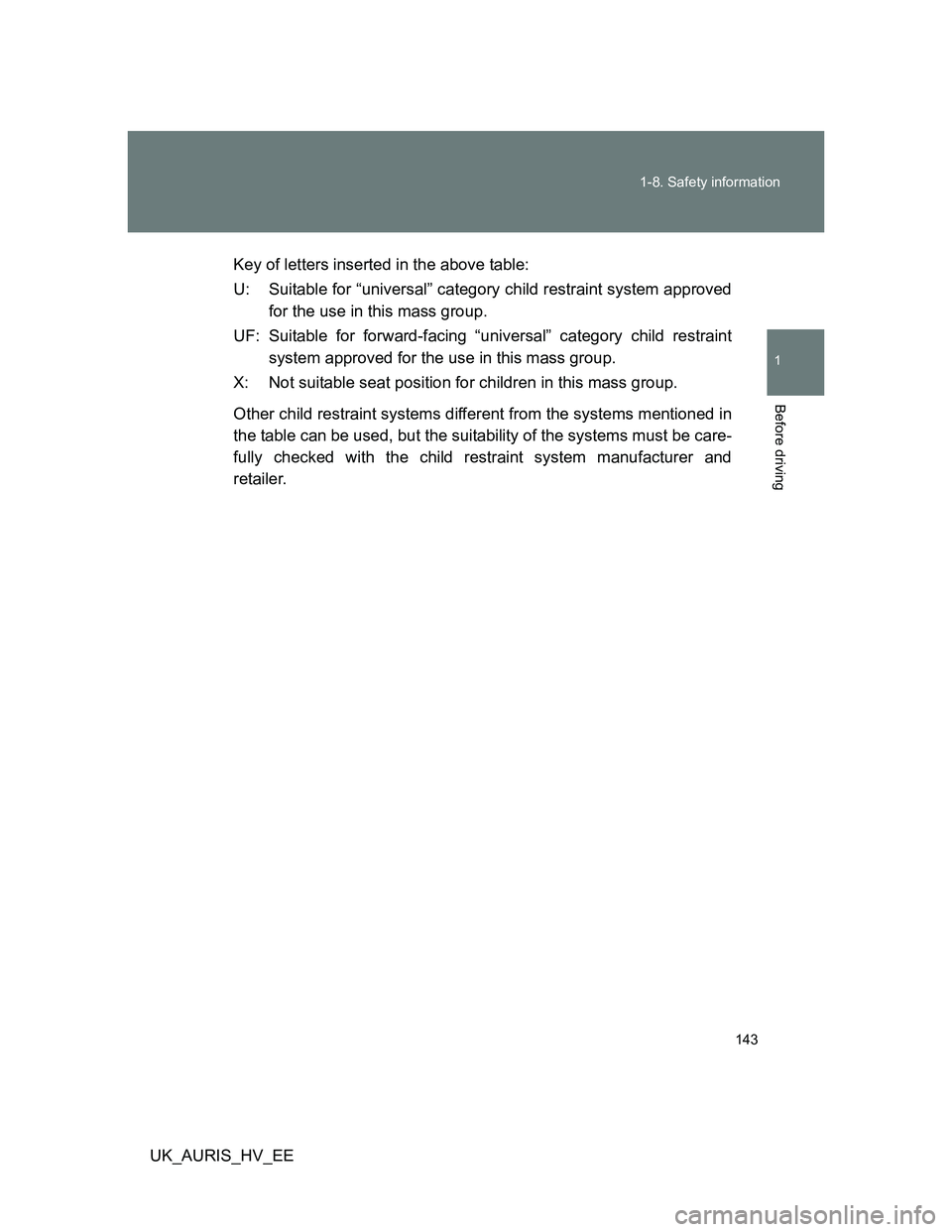
143 1-8. Safety information
1
Before driving
UK_AURIS_HV_EEKey of letters inserted in the above table:
U: Suitable for “universal” category child restraint system approved
for the use in this mass group.
UF: Suitable for forward-facing “universal” category child restraint
system approved for the use in this mass group.
X: Not suitable seat position for children in this mass group.
Other child restraint systems different from the systems mentioned in
the table can be used, but the suitability of the systems must be care-
fully checked with the child restraint system manufacturer and
retailer.
Page 144 of 524
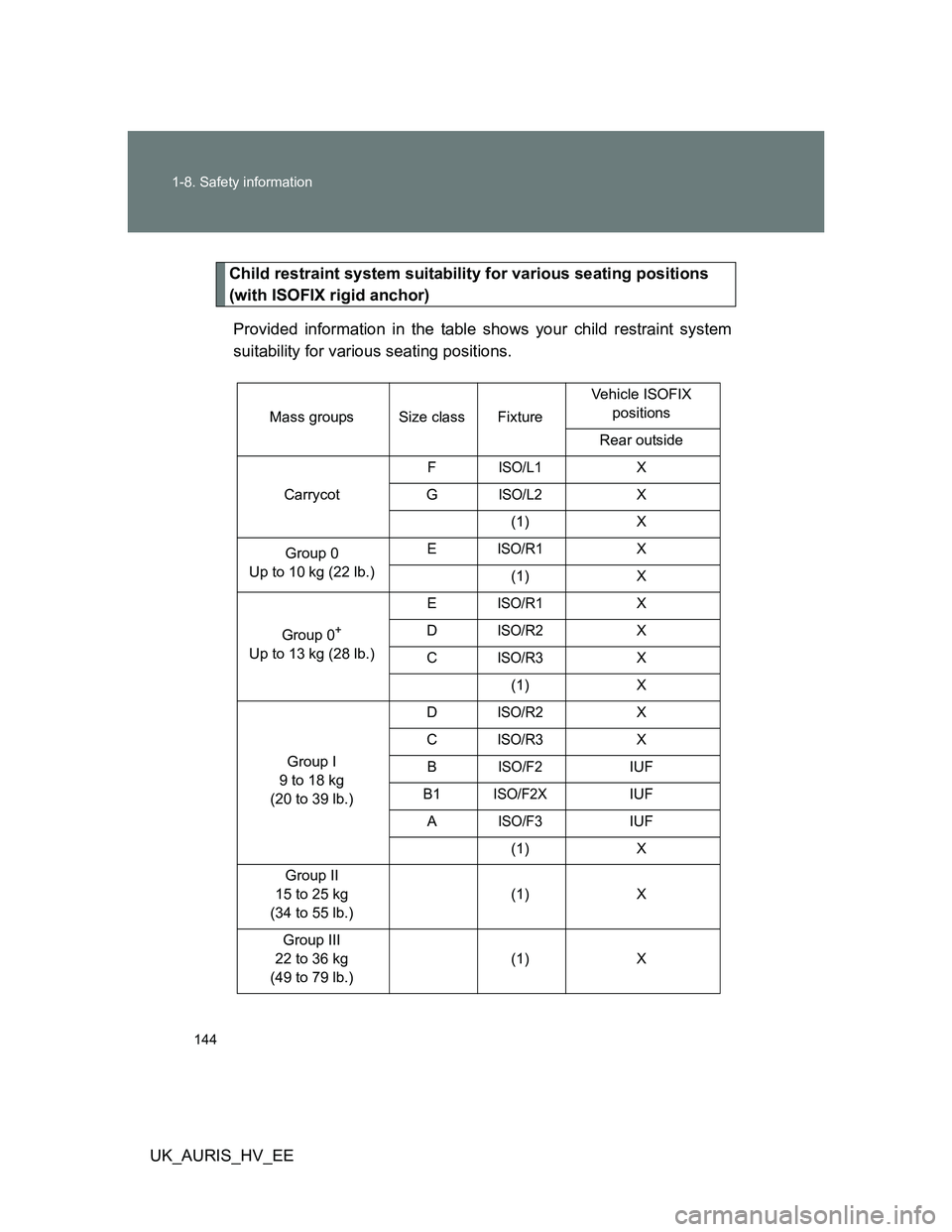
144 1-8. Safety information
UK_AURIS_HV_EE
Child restraint system suitability for various seating positions
(with ISOFIX rigid anchor)
Provided information in the table shows your child restraint system
suitability for various seating positions.
Mass groups Size class FixtureVehicle ISOFIX
positions
Rear outside
CarrycotF
ISO/L1X
G
ISO/L2X
(1) X
Group 0
Up to 10 kg (22 lb.)E
ISO/R1X
(1) X
Group 0
+
Up to 13 kg (28 lb.)E
ISO/R1X
D
ISO/R2X
C
ISO/R3X
(1) X
Group I
9 to 18 kg
(20 to 39 lb.)D
ISO/R2X
C
ISO/R3X
B
ISO/F2IUF
B1
ISO/F2XIUF
A
ISO/F3IUF
(1) X
Group II
15 to 25 kg
(34 to 55 lb.)(1) X
Group III
22 to 36 kg
(49 to 79 lb.)(1) X
Page 145 of 524
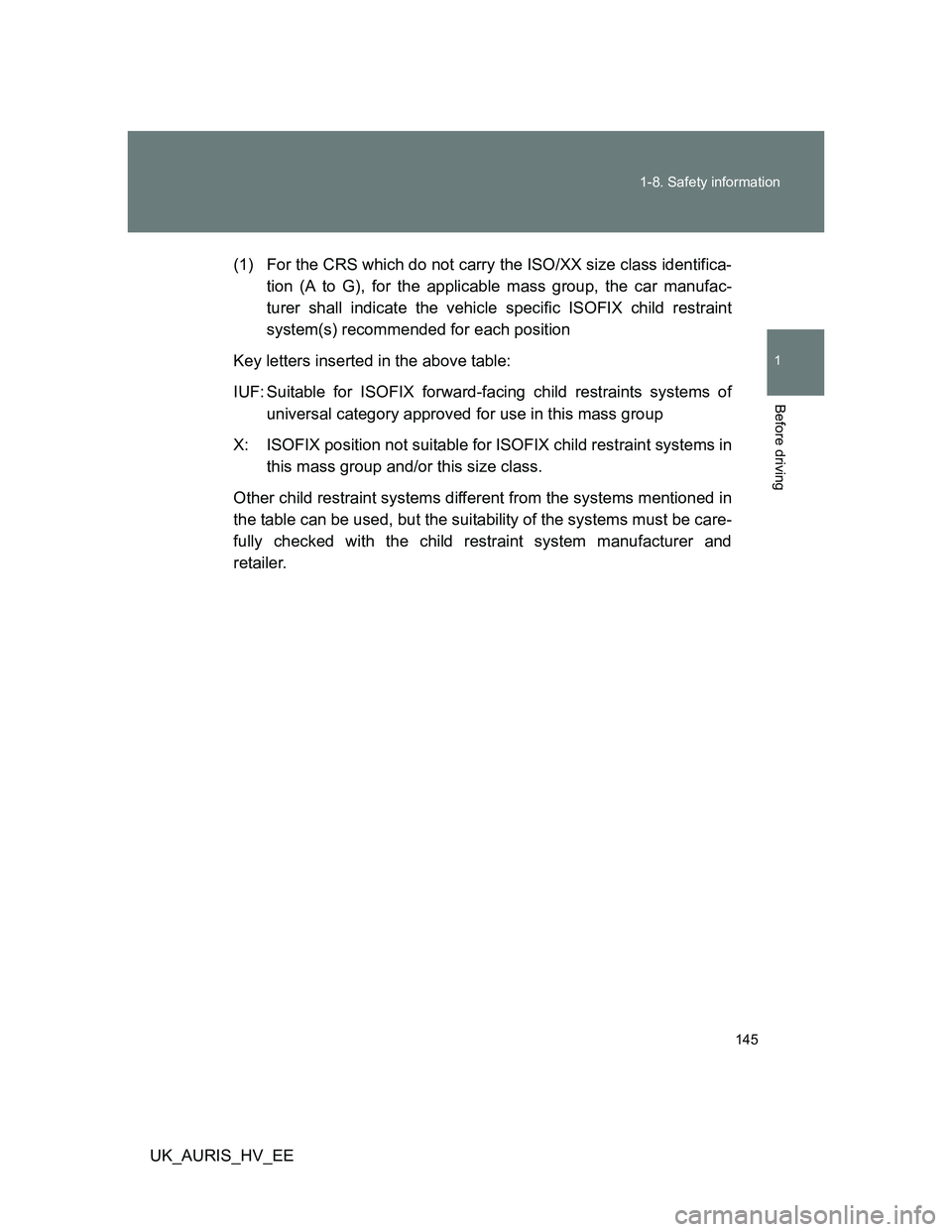
145 1-8. Safety information
1
Before driving
UK_AURIS_HV_EE(1) For the CRS which do not carry the ISO/XX size class identifica-
tion (A to G), for the applicable mass group, the car manufac-
turer shall indicate the vehicle specific ISOFIX child restraint
system(s) recommended for each position
Key letters inserted in the above table:
IUF: Suitable for ISOFIX forward-facing child restraints systems of
universal category approved for use in this mass group
X: ISOFIX position not suitable for ISOFIX child restraint systems in
this mass group and/or this size class.
Other child restraint systems different from the systems mentioned in
the table can be used, but the suitability of the systems must be care-
fully checked with the child restraint system manufacturer and
retailer.
Page 146 of 524
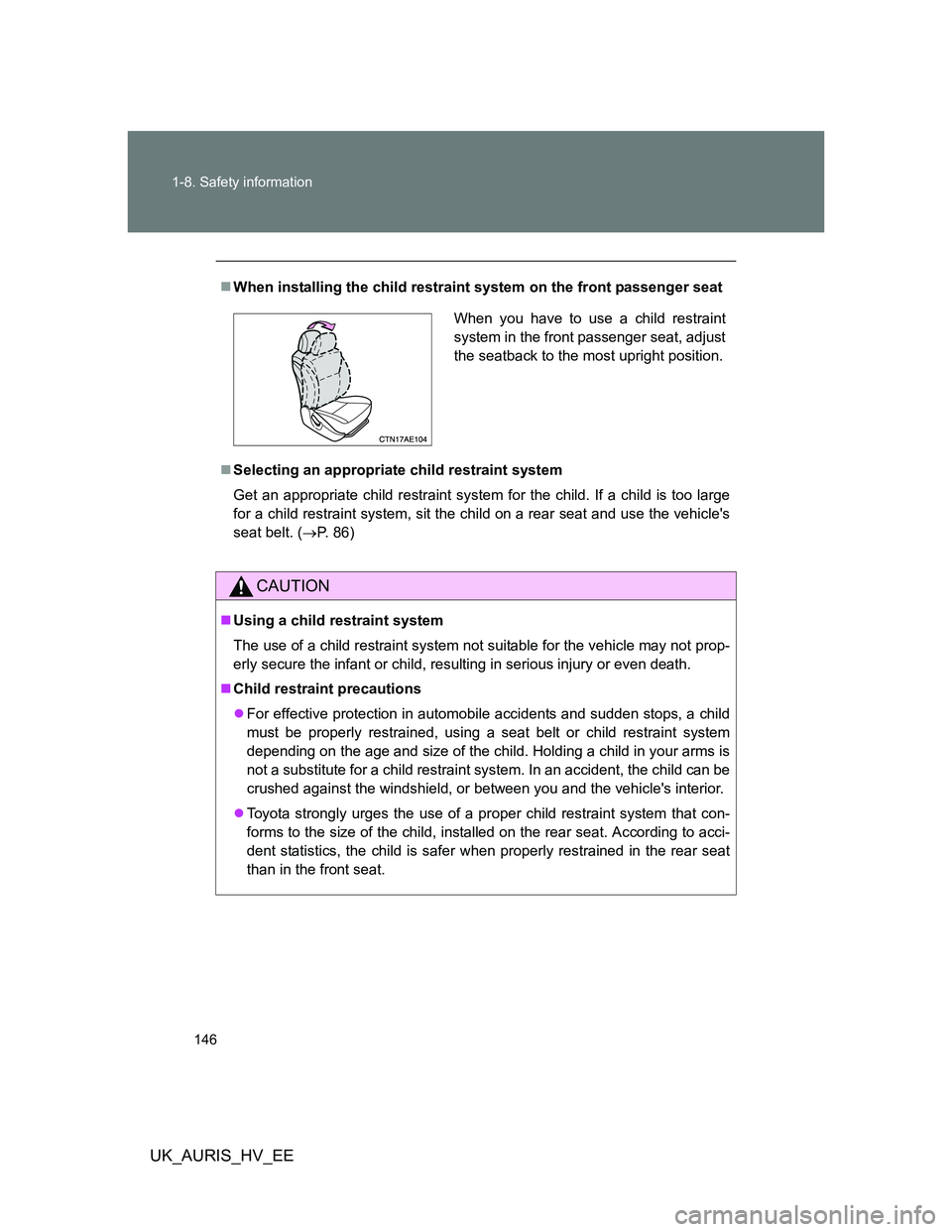
146 1-8. Safety information
UK_AURIS_HV_EE
When installing the child restraint system on the front passenger seat
Selecting an appropriate child restraint system
Get an appropriate child restraint system for the child. If a child is too large
for a child restraint system, sit the child on a rear seat and use the vehicle's
seat belt. (P. 86)
CAUTION
Using a child restraint system
The use of a child restraint system not suitable for the vehicle may not prop-
erly secure the infant or child, resulting in serious injury or even death.
Child restraint precautions
For effective protection in automobile accidents and sudden stops, a child
must be properly restrained, using a seat belt or child restraint system
depending on the age and size of the child. Holding a child in your arms is
not a substitute for a child restraint system. In an accident, the child can be
crushed against the windshield, or between you and the vehicle's interior.
Toyota strongly urges the use of a proper child restraint system that con-
forms to the size of the child, installed on the rear seat. According to acci-
dent statistics, the child is safer when properly restrained in the rear seat
than in the front seat.
When you have to use a child restraint
system in the front passenger seat, adjust
the seatback to the most upright position.
Page 147 of 524
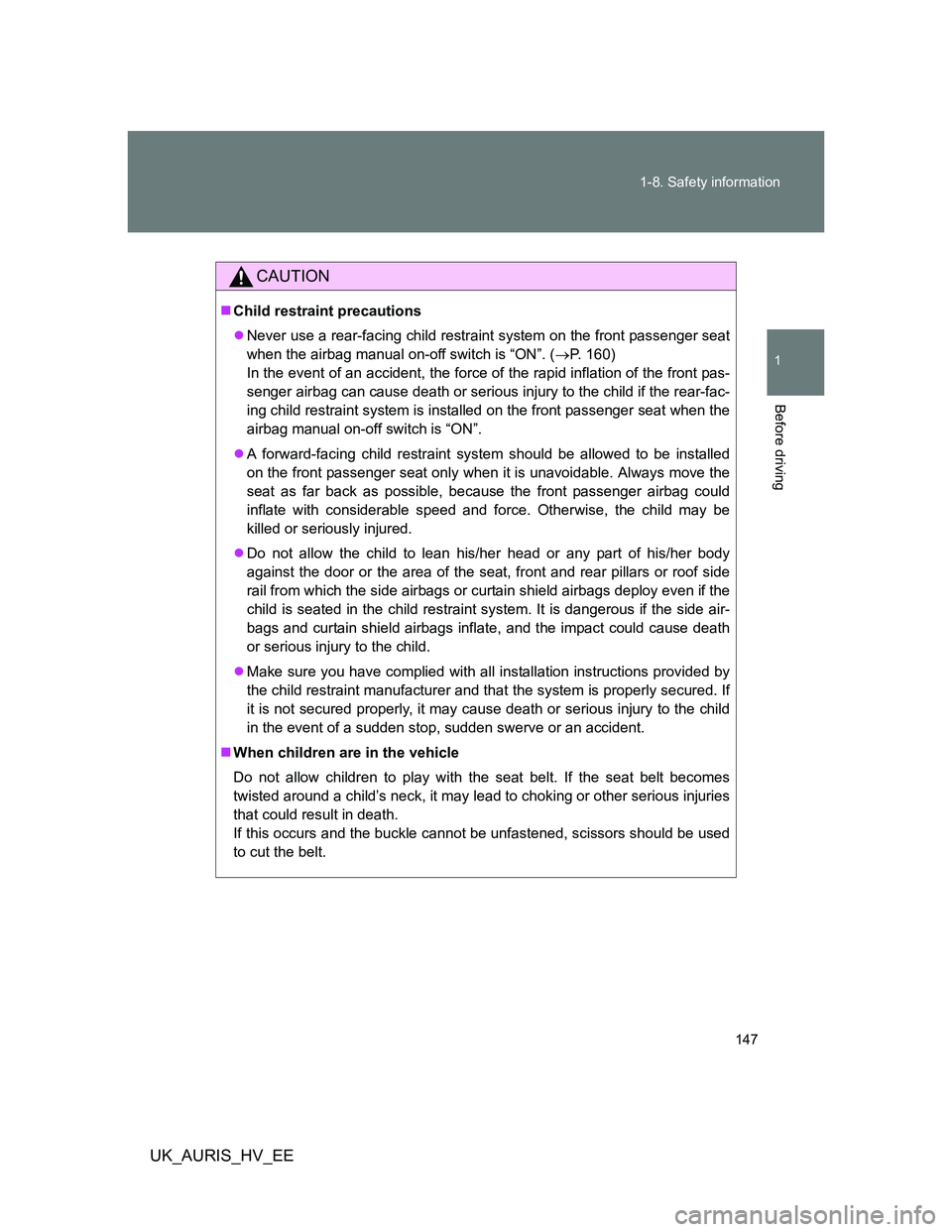
147 1-8. Safety information
1
Before driving
UK_AURIS_HV_EE
CAUTION
Child restraint precautions
Never use a rear-facing child restraint system on the front passenger seat
when the airbag manual on-off switch is “ON”. (P. 160)
In the event of an accident, the force of the rapid inflation of the front pas-
senger airbag can cause death or serious injury to the child if the rear-fac-
ing child restraint system is installed on the front passenger seat when the
airbag manual on-off switch is “ON”.
A forward-facing child restraint system should be allowed to be installed
on the front passenger seat only when it is unavoidable. Always move the
seat as far back as possible, because the front passenger airbag could
inflate with considerable speed and force. Otherwise, the child may be
killed or seriously injured.
Do not allow the child to lean his/her head or any part of his/her body
against the door or the area of the seat, front and rear pillars or roof side
rail from which the side airbags or curtain shield airbags deploy even if the
child is seated in the child restraint system. It is dangerous if the side air-
bags and curtain shield airbags inflate, and the impact could cause death
or serious injury to the child.
Make sure you have complied with all installation instructions provided by
the child restraint manufacturer and that the system is properly secured. If
it is not secured properly, it may cause death or serious injury to the child
in the event of a sudden stop, sudden swerve or an accident.
When children are in the vehicle
Do not allow children to play with the seat belt. If the seat belt becomes
twisted around a child’s neck, it may lead to choking or other serious injuries
that could result in death.
If this occurs and the buckle cannot be unfastened, scissors should be used
to cut the belt.
Page 148 of 524
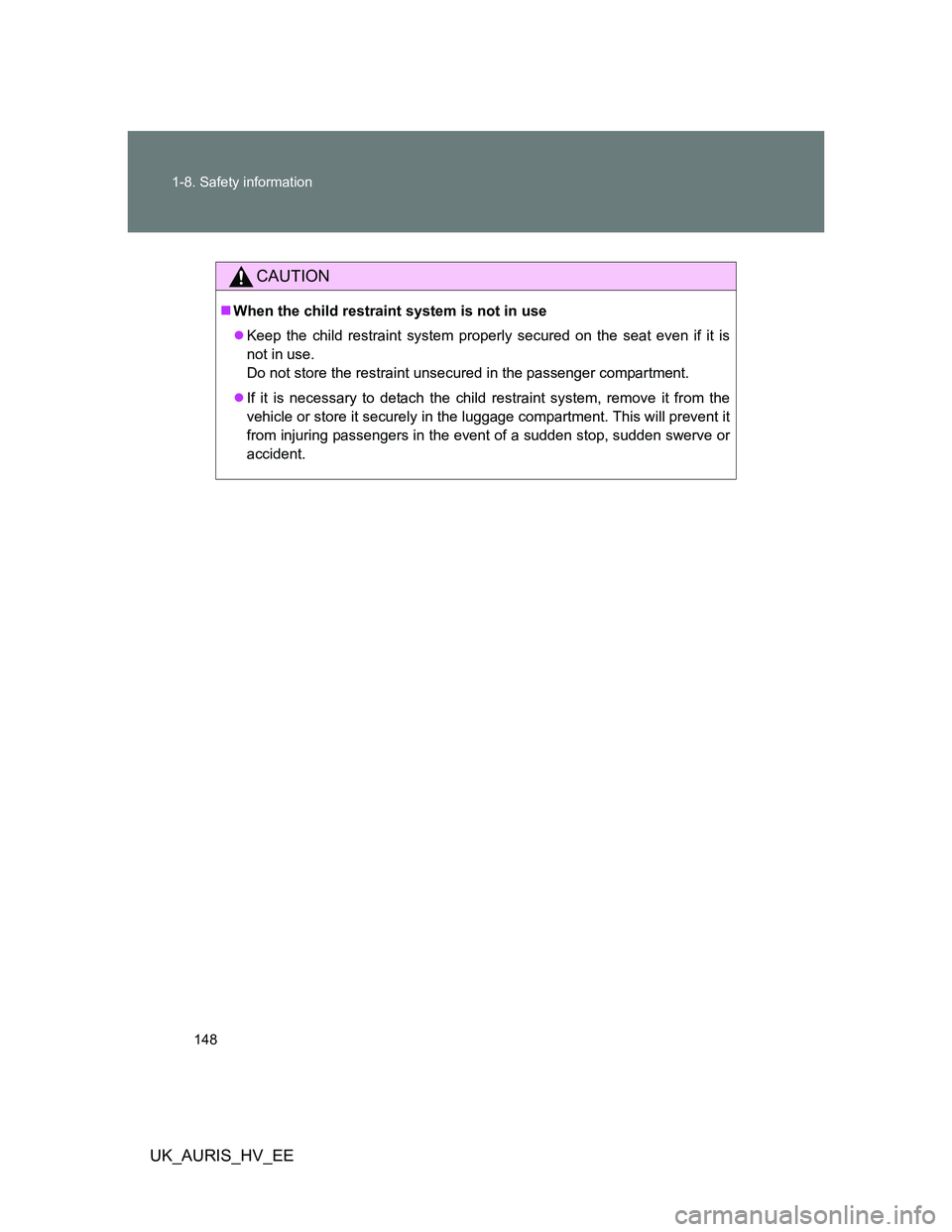
148 1-8. Safety information
UK_AURIS_HV_EE
CAUTION
When the child restraint system is not in use
Keep the child restraint system properly secured on the seat even if it is
not in use.
Do not store the restraint unsecured in the passenger compartment.
If it is necessary to detach the child restraint system, remove it from the
vehicle or store it securely in the luggage compartment. This will prevent it
from injuring passengers in the event of a sudden stop, sudden swerve or
accident.
Page 149 of 524
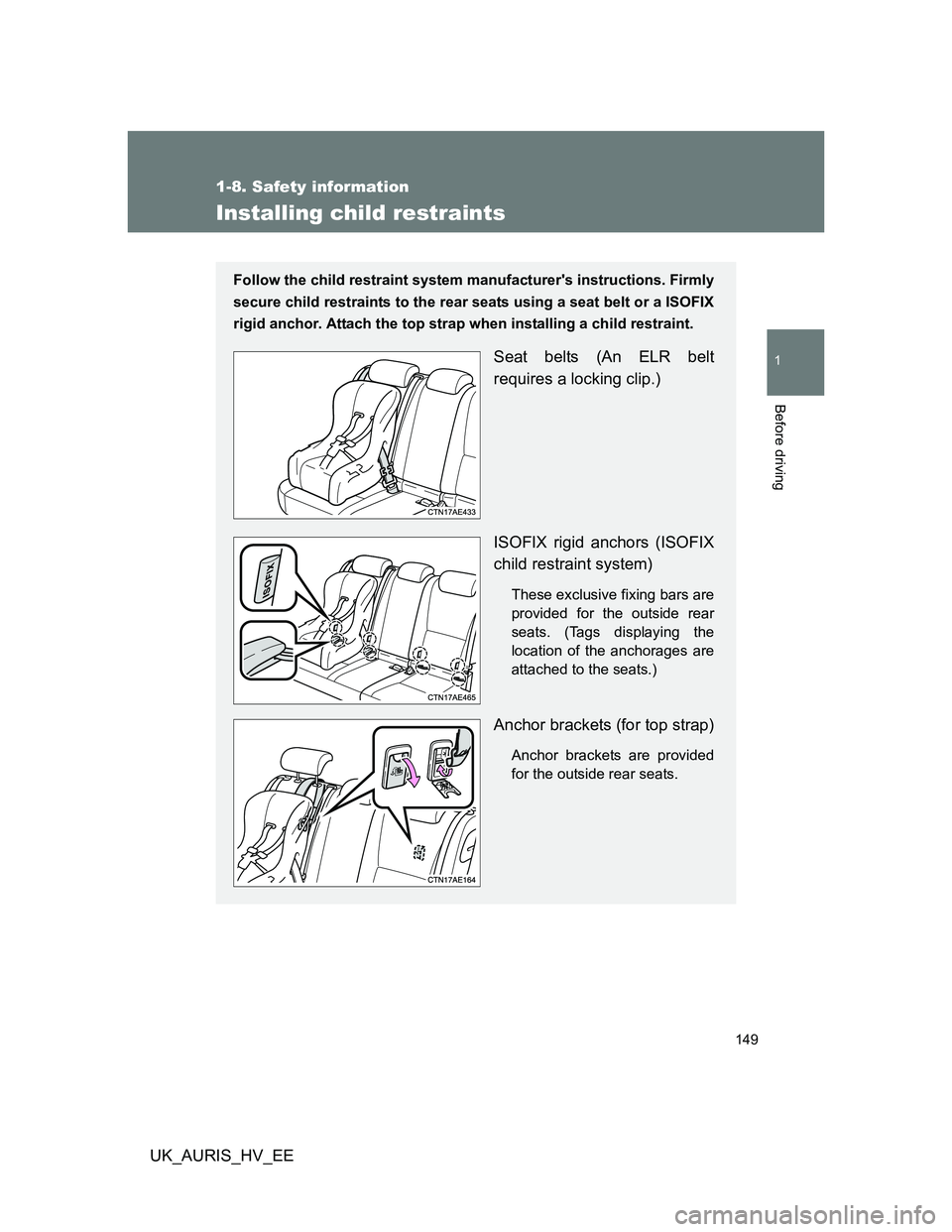
149
1
1-8. Safety information
Before driving
UK_AURIS_HV_EE
Installing child restraints
Follow the child restraint system manufacturer's instructions. Firmly
secure child restraints to the rear seats using a seat belt or a ISOFIX
rigid anchor. Attach the top strap when installing a child restraint.
Seat belts (An ELR belt
requires a locking clip.)
ISOFIX rigid anchors (ISOFIX
child restraint system)
These exclusive fixing bars are
provided for the outside rear
seats. (Tags displaying the
location of the anchorages are
attached to the seats.)
Anchor brackets (for top strap)
Anchor brackets are provided
for the outside rear seats.
Page 150 of 524
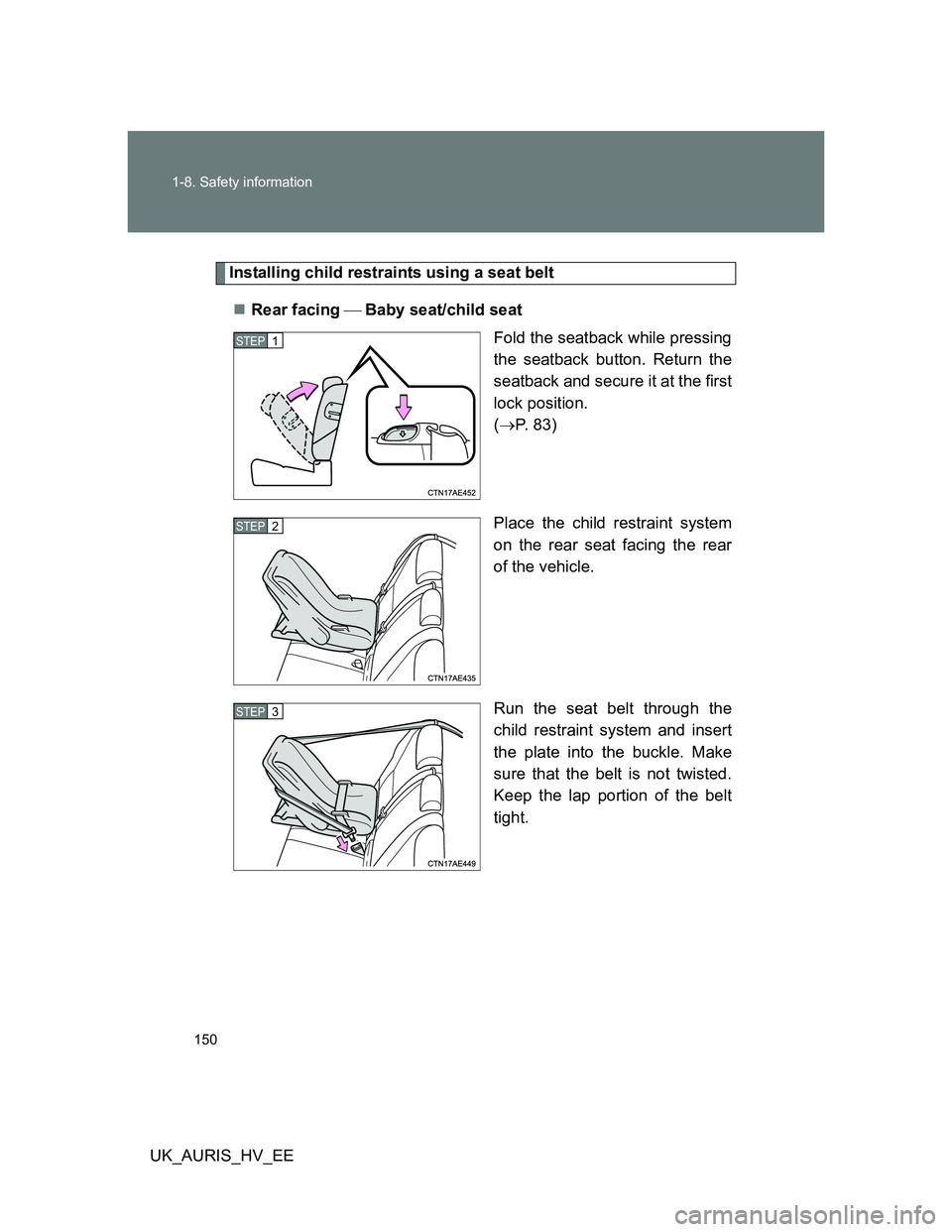
150 1-8. Safety information
UK_AURIS_HV_EE
Installing child restraints using a seat belt
Rear facing Baby seat/child seat
Fold the seatback while pressing
the seatback button. Return the
seatback and secure it at the first
lock position.
(P. 8 3 )
Place the child restraint system
on the rear seat facing the rear
of the vehicle.
Run the seat belt through the
child restraint system and insert
the plate into the buckle. Make
sure that the belt is not twisted.
Keep the lap portion of the belt
tight.
STEP1
STEP2
STEP3